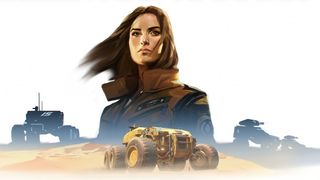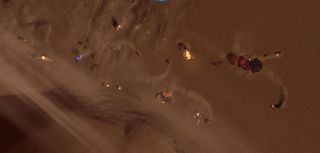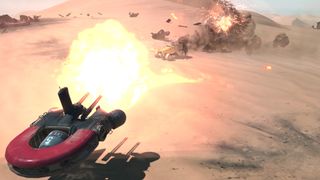In Homeworld: Deserts of Kharak there’s still space in the desert

The original Homeworld games are widely considered RTS classics. Their zero-g, topsy-turvy gameplay pitted you against unrelenting swarms of enemy ships and the infinite, damning vacuum of space. Interest in another Homeworld game had never completely died out, but after years and years of IP juggling, it seemed nothing would come of the franchise for a while yet.
Lo! There’s a whole new Homeworld game coming out next week. Say it again. Next week. Blackbird Interactive, a conglomerate of developers hailing from the original Homeworld games and elsewhere, is finally going to release Homeworld: Deserts of Kharak. But this time, gameplay takes place on the ground and there’s a concerted focus on personal storytelling—a huge, somewhat worrisome departure for the franchise. But Rob Cunningham, CEO of Blackbird, and Rory McGuire, Lead Game Designer aren’t worried. They stopped by recently to show me a few campaign missions from Deserts of Kharak and how it embodies and iterates on their classic take of the RTS formula.
Marooned
Deserts of Kharak’s basic gameplay loop will be familiar to Homeworld players. A grounded ‘mothership’ acts as a hub for vehicles, upgrades, and mineral processing. Smaller units with varying rock-paper-scissors specialties act as offense, defense, scouts, and so on. Each mission offers up some kind of variety, whether defending a mobile story character as they investigate a familiar shipwreck or navigating a dangerous sandstorm while enemies attack your flank with reckless abandon. At first, I was a bit worried that pulling Homeworld down to terra firma would drain the game of its somber identity. Space as a backdrop made the journey feel impossible, desperate. Zooming out on space battles drove home how small and insignificant your meager fleet actually was. It was oppressive and difficult—especially because units carried over between missions. Kharak appears to keep that sensibility intact though. The environments are massive, and use of the tactical overhead camera from the prior games is absolutely necessary. Dunes tower like mountains and canyons split the map into a maze of chokepoints. Zoom out far enough and it starts to look like Google Earth.

Click on a unit it to move it, and a circle forms beneath it to show distance in 360 degrees. This was useful in space, where relative distance is hard to make out in a black void, but now it has a new purpose. In Kharak, movement along the Z-axis is out, and instead the circle displays a ton of information about terrain advantage. It’s like a live topographical map that changes depending on where you move the cursor relative to the selected unit. As you move your mouse further from the unit and the circle grows, it’ll reveal lines that determine changes in elevation: if the highlighted space is orange, then moving your unit there will provide a disadvantage. Blue? That’s advantageous terrain. Move a unit there for a damage buff and an ego boost. If you’re planning an attack move, red lines between the selected units and designated attack area communicate lines of fire. A solid red line means you have a clear shot, while a dotted red line means the shot is obstructed.
It’s a ton of information displayed in an elegant way, and vital for the accessibility needed in an RTS. With a few clicks, the player can easily parse some of the most important information in the game. What remains to be seen is how important it remains forty minutes into a harrowing scenario. I’ve yet to have a go at Kharak’s terrain tactics over the course of a mission (or the entire campaign) myself, so it’s hard to say how balanced, interesting, and complex they can get. Worst case, each match boils down to a lame bout of king of the hill. My fantasy: using dunes for cover to perform stealthy flanks, creating new choke points through dune deformation, and doing it all with relative ease.

Truck voyeurism
My biggest takeaway from the demo was how gorgeous it all looks. McGuire loaded up a night mission and sent some dune buggies to scout ahead, a menial task in most RTS games. But then he transitioned the bird's eye camera from the sky to follow the buggies from behind on the ground. He hit a button and the UI disappeared. What was left looked like something out of a movie. A starry night sky lit up the desert floor in deep blues while the buggies weaved in and out of one another, leaving behind a trail of dust. When zoomed in, the amount of detail work on the vehicles is hard to ignore. Each buggy’s wheels had independently moving suspension on their wheels, logos were readable, and they adjusted to every change in terrain according to their velocity. The vehicles feel like they behave according to their physics, like conceivable machines rather than abstract polygonal toys. Vehicle lust is alive and well in Deserts of Kharak.
Homeworld: Deserts of Kharak is looking really, really nice. I was taken aback at exactly how much appears to have gone into the game, but then again, it’s coming out of nowhere. A nice surprise, but also somewhat disconcerting. Without a proper hands-on, I can’t comment on how it actually feels to play, and as such a slow burn experience, Homeworld takes hours to truly get to grips with. Are the desert environments varied and interesting enough to be worth the departure from space? Not sure. Is the story any good? The presentation seems to be, but I don’t know. What about the multiplayer? We’ll get back to you on that. Luckily, it won’t be long. Homeworld: Deserts of Kharak comes out January 20th.
The biggest gaming news, reviews and hardware deals
Keep up to date with the most important stories and the best deals, as picked by the PC Gamer team.
James is stuck in an endless loop, playing the Dark Souls games on repeat until Elden Ring and Silksong set him free. He's a truffle pig for indie horror and weird FPS games too, seeking out games that actively hurt to play. Otherwise he's wandering Austin, identifying mushrooms and doodling grackles.
Most Popular

